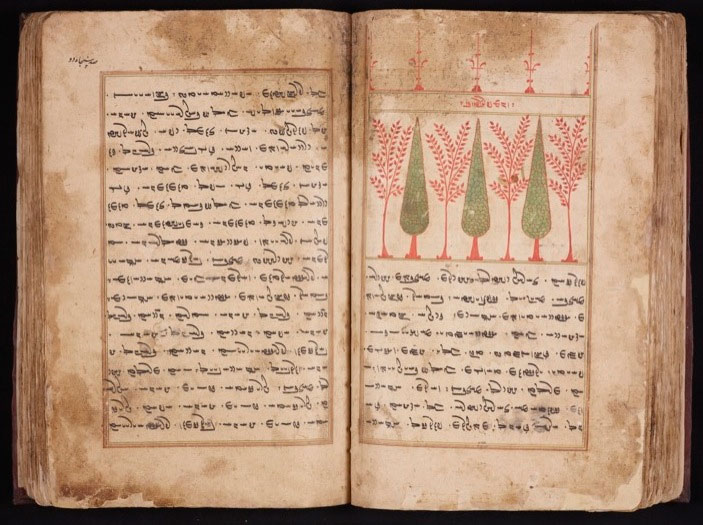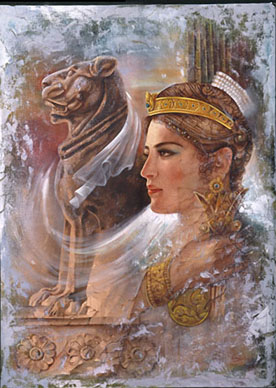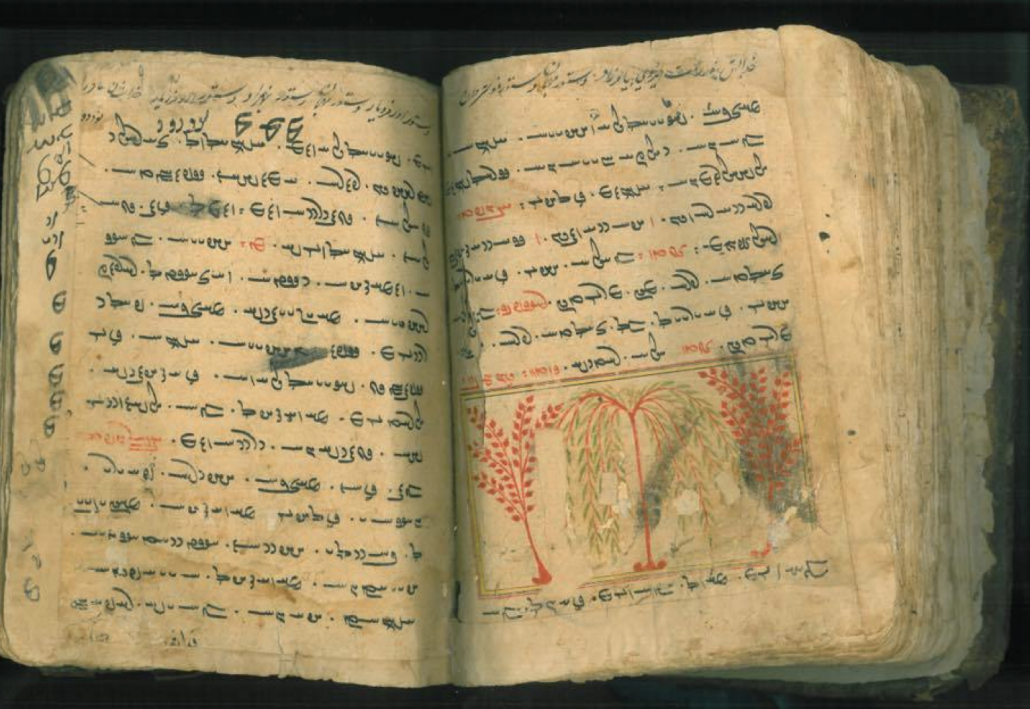The article below by Ahmad Tafazzoli entitled “Education in the Parthian and Sassanian Empires” was originally published in the Encyclopedia Iranica on December 15, 1997 and last updated on December 9, 2011. The article is also available in print (Vol. VIII, Fasc. 2, pp. 179-180).
Kindly note that the pictures/illustrations and accompanying descriptions of these inserted below do not appear in the original Encyclopedia Iranica posting.
====================================================================
No concrete evidence on education in Parthian times has survived. It may be postulated, however, that it was similar to education in the Sasanian period. Information about the latter period is confined mainly to education of princes, the nobility, the clergy, and administrative secretaries (dabīrs). Most peasants were illiterate, but most urban merchants were probably acquainted at least with writing and calculation (Christensen, Iran Sass., p. 416).
The required education for a child of a noble or an upper-class family is described in the Pahlavi treatise Xusraw ud Rēdag (Pahlavi Texts, ed. Jamasp-Asana, pp. 27-38): writing, religious instruction, physical education, and training in courtly arts. A noble child would begin attending school (fra-hangestān) at the “proper age,” between five and seven years (Wizīrkard, p. 177; cf. Ṭabarī, I, pp. 815, 855: Ardašīr at seven years, Bahrām V at five years) and would have completed general training and religious studies by the age of fifteen years (Andarz ī Pōryōtkēšān, par. 1; Pahlavi Texts, ed. Jamasp-Asana, p. 41). At school he would learn to write and would memorize the yašts, Hādōxt, Bayān Yasn, and Vidēvdād, the same training provided for a future hērbed (religious teacher). In addition, he would listen to the Zand, the Pahlavi translation of the Avesta. Astrology was also part of the curriculum (Xusraw ud Rēdag,pars. 8-10, 14). The education of a certain Mihrām-Gušnasp, son of a noble Sasanian family who later converted to Christianity and was martyred, was similar. He was said to have been initiated into Middle Persian literature and the Zoroastrian religion at an early age. He could recite the yašts and hold the barsom at the age of seven years (Hoffmann, p. 94; Christensen, Iran Sass., pp. 413-14). According to Abū Manṣūr Ṯaʿālebī (Ḡorar, p. 712), Šīrōya (later Kavad II, r. 628 C.E.) read Kalīla wa Demna at school.

A copy of the Avestan Videvdad Sadeh with illustrations housed at the British Library (RSPA 230, ff. 151v–152r) (Source: Maia Atlantis). The text above was originally copied in 1647 in Yazd, Iran.
The account of the education of Dārāb given in the Šāh-nāma (Moscow, VI, pp. 359-60, vv. 93-103; cf. Ṯaʿālebī, Ḡorar, p. 394; cf. Xusraw ud Rēdag, pars. 11-12) probably reflects Sasanian norms: He first learned the Avesta and Zand and was then trained in riding, archery, polo, and the military arts. It was customary to entrust the education of a prince, especially a crown prince, to a tutor, in some instances far from the court. For example, at the end of the Arsacid period Bābak sent Ardašīr (224-40) at the age of seven years to the argbed Tīrī, who was probably commander of the fortress of Dārābgerd (see DĀRĀB ii), to be educated (Ṭabarī, I, p. 815; Balʿamī, ed. Bahār, p. 876). Writing (dibīrīh), riding (aswārīh), and other skills were parts of his education (Kār-nāmag, ed. Antia, chap. II, p. 5 par. 4). Ardašīr himself, while at the court of the last Arsacid king, Ardavān (see ARTABANUS), had trained princes in horsemanship and hunting (Ṯaʿālebī, Ḡorar, p. 475). Bahrām V (Bahrām Gōr; 421-39), whose education was said to have been entrusted to Monḏer, Arab ruler of Ḥīra in Mesopotamia, was instructed by various tutors (moʾaddeb) in writing, archery, riding, and law. His general education is reported to have finished at the age of twelve years, after which he continued training in archery and riding until he attained mastery (Ṭabarī, I, pp. 855-57; Meskawayh, pp. 78-79; Dīnavarī, ed. Guirgass, p. 53; Ṯaʿālebī, Ḡorar, p. 541; Šāh-nāma, Moscow, VII, pp. 270-71; Balʿamī, ed. Bahār, pp. 929-30).
A noble education also involved learning to play musical instruments and sing, games like chess and backgammon, and general information about wines, flowers, women, and riding animals (Xusraw ud Rēdag, pars. 13, 15, 57-58, 62-63, 66, 69-93, 96, 99-100). When Ardašīr was relegated by Ardavān to service in the royal stable, he reportedly amused himself by playing the lute (ṭanbūr) and singing (srōd-wāzīg; Kār-nāmag, ed. Antia, chap. 3, p. 11 par. 2; cf. Šāh-nāma, ed. Khaleghi, II, p. 30, VI, p. 178, about Rostam and Esfandīār respectively).

An artistic interpretation of the ancient Iranian Goddess of knowledge and science, Cheesta (Source: Mojarradat). The Avesta makes clear that women are equal to men in receiving education: there is a reference for example to the worship of frauuaṣ̌is (choices) of aēθrapaitinąm aēθriianąm narąm nāirinąm (teachers, of students—male Ferdowsī’s description of the education of Prince Sīāvaš by Rostam in Zābol provides a model of princely education in Sasanian and probably Parthian times as well. The prince was not only trained in horsemanship, archery, hunting, and the arts of war but also learned social etiquette, ceremonial rites, conduct on festive occasions, and delivery of orations. The results of his education were later apparent in the skills in archery, polo, and hunting that he exhibited when he lived at the court of Afrāsīāb (Šāh-nāma, ed. Khaleghi, II, pp. 207, 289-94). There is some evidence that in the Sasanian period women attended school, at least for general religious studies, though probably in relatively small numbers (Kotwal and Kreyenbroek, pp. 18, 38, 43); the main part of their training, however, consisted of domestic skills learned at home (Dēnkard, ed. Madan, I, p. 935; Christensen, Iran Sass., p. 418). There is one piece of evidence suggesting that some women were well versed in Sasanian civil law (Bartholomae, p. 35; Christensen, Iran Sass., p. 418). Three terms for “school” are attested in Pahlavi books: frahangestān, lit., “place of education” (Xusraw ud Rēdag, par. 8; Kār-nāmag, ed. Antia, chap. 2, p. 8 par. 21); dibīrestān, probably a school for training scribes and secretaries (Andarz ī Ādurbād, pars. 58, 129, in Pahlavi Texts, ed. Jamasp-Asana, pp. 63, 69; Xwēškārīh ī Rēdagān, pars. 1, 3, 5, 23, in Junker, pp. 15, 16, 20; Sad dar naṯr, chap. 51, p. 37); and hērbedestān, evidently a school for religious studies (Andarz ī Pōryōtkēšān, par. 8, in Pahlavi Texts, ed. Jamasp-Asana, p. 43; Andarz ō kōdakān, par. 25, in Junker, p. 20). The general term for “teacher” was hammōzgār, for “religious teacher” hērbed, and for “instructor” frahangbed (Dēnkard, ed. Madan, pp. 274, 757; cf. Ṭabarī, I, p. 1063: moʾaddeb al-asāwera “instructor of horsemen”). A newly discovered Yasna manuscript announced on the Bibliographia Iranica on June 26, 2015 by Shervin Farridnejad (Source: Bibliographia Iranica). This discovery was first announced by Dr. Saloume Gholami on Facebook. Professor Alberto Cantera and his colleagues at the Avestan Digital Archive (ADA) project have been working to publish the manuscript and make it available for public access. This manuscript originally belongs to the Dinyar family of Yazd, Iran and has been dated to c. 1630. The sources provide scanty information on educational methods. In two Pahlavi treatises (Xwēškārīh ī Rēdagān and Andarz ō kōdakān) that have survived in Pāzand, the duties of boys at school, at home, and on the way from home to school are described (Junker, pp. 15-21). Physical punishment was administered at school (cf. Zādspram, chap. 27, p. 97 par. 8; Pahlavi Texts, ed. Jamasp-Asana, p. 130, par. 9, where beating with a very long stick is mentioned). Bibliography (For cited works not found in this bibliography and abbreviations found here, see “Short References.”) C. Bartholomae, Zum sassanidischen Recht IV, Sb. der Heidelberger Akademie der Wissenschaften 13, Heidelberg, 1922/5. G. Hoffmann, Auszüge aus syrischen Akten persischer Märtyrer, Leipzig, 1880. H. F. J. Junker, ed., Ein mittelpersisches Schulgespräch, Sb. der Heidelberger Akademie der Wissenschaften 3/15, Heidelberg, 1912. F. M. Kotwal and P. Kreyen-broek, The Hērbedestān and Nērangestān I, Paris, 1992. Meskawayh, Tajāreb al-omam I, ed. A. Emāmī, Tehran, 1366 Š/1987. Sad dar naṯr, ed. B. N. Dhabhar, Bombay, 1909. Wizīrkard ī dēnīg, ed. P. Sanjana, Bombay, 1848.



